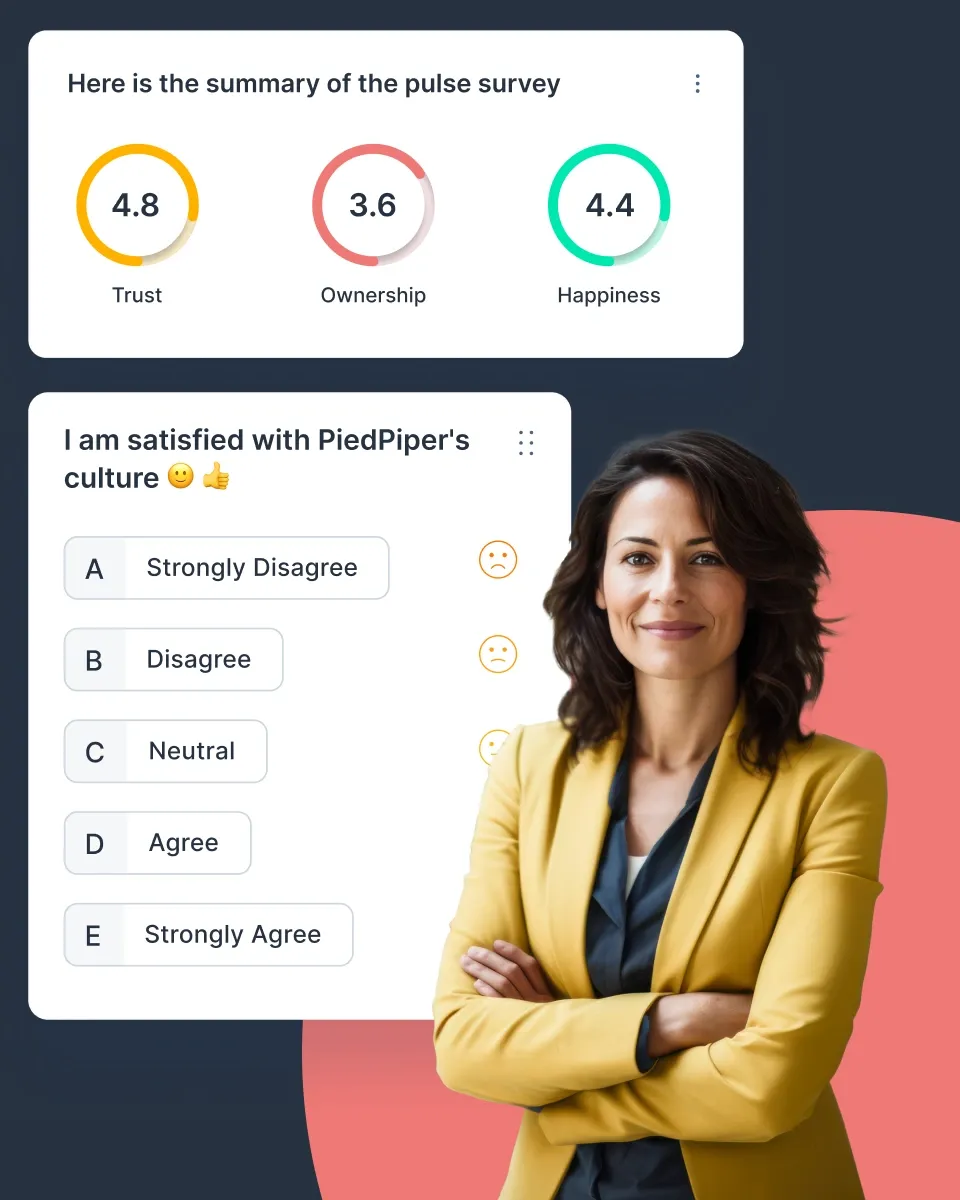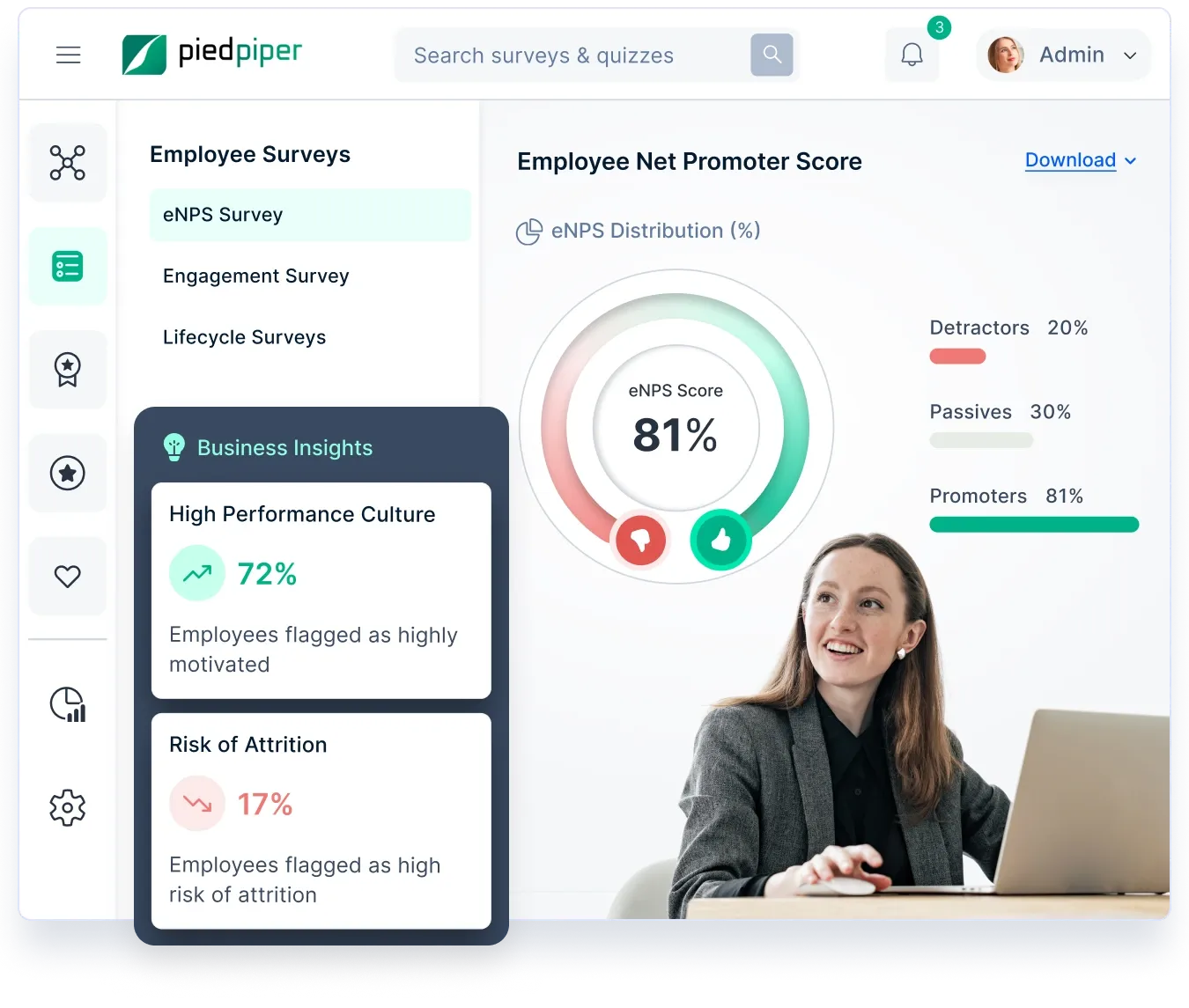Ein vollständiger Leitfaden für 360-Grad-Feedback: Prozess, Fragen und Beispiele 360-Grad-Feedback
Ein 360-Grad-Feedback bietet eine umfassende Bewertung, indem Erkenntnisse von Managern, Kollegen, Untergebenen und Kunden gesammelt werden. Dieser Leitfaden behandelt den 360-Grad-Feedback-Prozess, die wichtigsten Fragen, die gestellt werden sollten, und praktische Beispiele, die Unternehmen dabei helfen, die Leistung ihrer Mitarbeiter zu verbessern.

Auf dieser Seite
- Was ist ein 360-Grad-Feedback?
- Was sollte in einem 360-Grad-Feedback enthalten sein?
- Warum ist die Durchführung einer 360-Grad-Feedback-Umfrage wichtig?
- 360-Grad-Feedback vs. Leistungsbeurteilung
- Welche sollten Sie verwenden?
- Wie wirksam ist 360-Grad-Feedback?
- Zu berücksichtigende Beschränkungen
- Bewährte Verfahren für die Durchführung eines effektiven 360-Grad-Feedback-Programms
- Umfassender 360-Grad-Feedback-Fragebogen
- Beispiele für 360-Grad-Feedback
- Verbessern Sie das 360-Grad-Feedback mit Empuls
- Schlussfolgerung
Eine 360-Grad-Feedback-Umfrage ist eine der effektivsten Methoden, um eine umfassende Bewertung der Leistung eines Mitarbeiters zu erhalten. Im Gegensatz zu herkömmlichen Beurteilungen, die sich ausschließlich auf den Input des Vorgesetzten stützen, werden beim 360-Grad-Feedback Erkenntnisse von Kollegen, Untergebenen, Managern und sogar Kunden gesammelt, um einen ganzheitlichen Blick auf die Stärken, Schwächen und den Einfluss eines Mitarbeiters am Arbeitsplatz zu erhalten.
Mit Hilfe von gut strukturierten 360-Grad-Feedback-Fragen können Unternehmen Kommunikationsfähigkeiten, Führungseffektivität, Teamarbeit und Problemlösungsfähigkeiten bewerten. Dieser Prozess fördert nicht nur die Selbsterkenntnis und das berufliche Wachstum, sondern verringert auch die Voreingenommenheit und liefert ein genaueres Bild von den Beiträgen eines Mitarbeiters.
In diesem Leitfaden werden wir Beispiele für 360-Grad-Feedback, wichtige Fragen für eine 360-Grad-Feedback-Umfrage und bewährte Verfahren zur Gewinnung verwertbarer Erkenntnisse vorstellen. Unabhängig davon, ob Sie das 360-Grad-Feedback zum ersten Mal einsetzen oder Ihren Ansatz verfeinern möchten, wird dieser Artikel Ihnen helfen, den Wert und die Auswirkungen auf die Mitarbeiterentwicklung zu verstehen.
Was ist ein 360-Grad-Feedback?
Das 360-Grad-Feedback ist eine Leistungsbewertungsmethode, bei der die Mitarbeiter Rückmeldungen aus verschiedenen Quellen erhalten, darunter Vorgesetzte, Kollegen, Untergebene und sogar Kunden. Dieser ganzheitliche Bewertungsprozess bietet eine abgerundete Perspektive auf die Stärken eines Mitarbeiters, die verbesserungswürdigen Bereiche und die Auswirkungen auf den Arbeitsplatz insgesamt.
Im Gegensatz zu herkömmlichen Leistungsbeurteilungen, die von oben nach unten durchgeführt werden, fördert das 360-Grad-Feedback konstruktive Einsichten aus verschiedenen Ebenen des Unternehmens und hilft den Mitarbeitern, sich beruflich weiterzuentwickeln, die Zusammenarbeit zu verbessern und sich an den Unternehmenszielen auszurichten.
Was sollte in einem 360-Grad-Feedback enthalten sein?
Ein gut strukturierter 360-Grad-Feedback-Prozess sollte mehrere Aspekte der Leistung, des Verhaltens und der beruflichen Entwicklung eines Mitarbeiters abdecken. Es umfasst in der Regel Rückmeldungen von Vorgesetzten, Kollegen, Untergebenen und manchmal auch Kunden und bietet eine ganzheitliche Sicht auf Stärken und verbesserungswürdige Bereiche.
- Kommunikationsfähigkeit: Wie gut kann der Mitarbeiter Ideen vermitteln und anderen zuhören?
- Zusammenarbeit und Teamwork: Wie gut arbeiten sie mit Kollegen zusammen und tragen zu einem positiven Teamumfeld bei?
- Führungsqualitäten und Entscheidungsfindung: Sind sie in der Lage, andere anzuleiten, die Initiative zu ergreifen und fundierte Entscheidungen zu treffen?
- Arbeitsleistung und Produktivität: Erfüllen sie die Erwartungen, liefern sie Qualitätsarbeit und bleiben sie verantwortungsbewusst?
- Anpassungsfähigkeit und Problemlösungsfähigkeit: Wie gut können sie mit Veränderungen, Herausforderungen und unerwarteten Situationen umgehen?
- Arbeitsmoral und Zuverlässigkeit: Sind sie verlässlich, proaktiv und konsequent in ihren Aufgaben?
- Emotionale Intelligenz: Wie gut können sie mit Emotionen umgehen, Feedback verarbeiten und starke Beziehungen am Arbeitsplatz aufbauen?
- Berufliche Entwicklung und Lernen: Sind sie offen für Lernen, Fortbildung und persönliches Wachstum?
Die Einbeziehung dieser Bereiche in das 360-Grad-Feedback gewährleistet eine umfassende, aufschlussreiche Bewertung, die den Mitarbeitern hilft, in ihrer Rolle zu wachsen und sich zu verbessern.
Warum ist die Durchführung einer 360-Grad-Feedback-Umfrage wichtig?
Eine 360-Grad-Feedback-Umfrage bietet eine umfassende Bewertung der Leistung eines Mitarbeiters, indem Erkenntnisse aus verschiedenen Quellen gesammelt werden, darunter Manager, Kollegen, Untergebene und Kunden. Im Gegensatz zu herkömmlichen Leistungsbeurteilungen verringert diese Methode die Voreingenommenheit und bietet eine umfassendere Perspektive. Sie hilft den Mitarbeitern, ihre Stärken zu erkennen, verbesserungswürdige Bereiche zu identifizieren und ihre Beziehungen am Arbeitsplatz zu verbessern.
1. Bietet eine ganzheitliche Sicht auf die Leistung
Das Sammeln von Feedback aus verschiedenen Quellen gewährleistet eine ausgewogenere und gerechtere Bewertung der Beiträge eines Mitarbeiters, als wenn man sich nur auf die Sichtweise einer Führungskraft verlässt.
2. Ermutigt zu beruflichem Wachstum und Entwicklung
Die Mitarbeiter erhalten wertvolle Einblicke in ihre Leistung, so dass sie sich persönliche Entwicklungsziele setzen und an verbesserungswürdigen Bereichen arbeiten können.
3. Verbessert Kommunikation und Teamarbeit
Die Mitarbeiter verstehen besser, wie sich ihr Handeln auf ihre Kollegen auswirkt, was zu einer besseren Zusammenarbeit, stärkeren Beziehungen und einem positiveren Arbeitsumfeld führt.
4. Reduziert Verzerrungen bei der Leistungsbewertung
Durch die Einbeziehung von Feedback aus verschiedenen Quellen können Unternehmen persönliche Voreingenommenheit minimieren und eine genauere und gerechtere Beurteilung der Mitarbeiter gewährleisten.
5. Verbessert die Effektivität der Führung
Manager und Führungskräfte können Stärken und verbesserungswürdige Bereiche ihres Führungsstils identifizieren und so eine engere Beziehung zu ihren Teams aufbauen und die Entscheidungsfindung verbessern.
Die Durchführung einer 360-Grad-Feedback-Umfrage hilft Unternehmen, eine Kultur der Transparenz, der Verantwortlichkeit und der kontinuierlichen Verbesserung zu fördern. Sie führt zu einem besseren Engagement der Mitarbeiter, einem höheren Leistungsniveau und stärkeren Beziehungen am Arbeitsplatz.
360-Grad-Feedback vs. Leistungsbeurteilung
Sowohl 360-Grad-Feedbacks als auch herkömmliche Leistungsbeurteilungen sind wichtige Instrumente zur Bewertung der Mitarbeiterleistung, unterscheiden sich jedoch erheblich in ihrem Ansatz, ihrem Zweck und ihren Ergebnissen. Das Verständnis dieser Unterschiede kann Unternehmen helfen, die richtige Methode für die Mitarbeiterentwicklung und Leistungsbeurteilung zu wählen.
Welche sollten Sie verwenden?
- Verwenden Sie 360-Grad-Feedback-Bewertungen, wenn das Ziel darin besteht, Führungsqualitäten zu entwickeln, die Kommunikation zu verbessern und die Teamarbeit zu optimieren. Diese Methode eignet sich am besten für persönliches Wachstum und berufliche Entwicklung.
- Verwenden Sie traditionelle Leistungsbeurteilungen, wenn Sie sich auf die Produktivität der Mitarbeiter, die Erreichung von Zielen und leistungsbezogene Belohnungen wie Beförderungen oder Gehaltsanpassungen konzentrieren.
Unternehmen können von einer Kombination beider Methoden profitieren, indem sie das 360-Grad-Feedback für die Mitarbeiterentwicklung und die Leistungsbeurteilung für strukturierte Bewertungen nutzen und so einen ganzheitlichen Ansatz für das Talentmanagement sicherstellen.
Wie wirksam ist 360-Grad-Feedback?
Ein 360-Grad-Feedbackprozess ist bei richtiger Umsetzung äußerst effektiv, da er einen umfassenden Überblick über die Leistung, die Fähigkeiten und den Einfluss eines Mitarbeiters am Arbeitsplatz bietet.
Durch das Einholen von Feedback aus verschiedenen Quellen, einschließlich Managern, Kollegen, Untergebenen und Kunden, können Unternehmen eine genauere und unvoreingenommene Beurteilung der Stärken und verbesserungswürdigen Bereiche einer Person erhalten.
1. Ermutigt zu abgerundeten Bewertungen
Da das Feedback aus verschiedenen Blickwinkeln kommt, bietet es eine umfassendere und objektivere Bewertung als herkömmliche Top-down-Bewertungen.
2. Fördert die Selbsterkenntnis und das Wachstum
Die Mitarbeiter erhalten Einblicke in ihre Leistung und ihre Interaktionen am Arbeitsplatz, wodurch sie Verbesserungsmöglichkeiten erkennen und neue Fähigkeiten entwickeln können.
3. Verbessert die Effektivität von Führung und Management
Die Führungskräfte erhalten konstruktives Feedback zu ihrem Führungsstil, so dass sie ihren Ansatz anpassen und ihre Teams besser unterstützen können.
4. Stärkt die Beziehungen am Arbeitsplatz und die Teamarbeit
Die Mitarbeiter verstehen, wie sich ihr Handeln auf andere auswirkt, was zu einer besseren Zusammenarbeit, Kommunikation und Konfliktlösung führt.
5. Reduziert Voreingenommenheit und Subjektivität
Herkömmliche Beurteilungen beruhen oft auf einer einzigen Perspektive, die voreingenommen sein kann. Das 360-Grad-Feedback sorgt für eine ausgewogenere Bewertung, indem es mehrere Blickwinkel einbezieht.
6. Verbessert das Engagement und die Bindung der Mitarbeiter
Wenn Mitarbeiter das Gefühl haben, gehört zu werden, und ein umsetzbares Feedback erhalten, sind sie eher motiviert und engagieren sich für ihre Aufgaben.
Zu berücksichtigende Beschränkungen
Ein 360-Grad-Feedback ist zwar effektiv, muss aber richtig durchgeführt werden, um die üblichen Fallstricke zu vermeiden. Organisationen sollten sicherstellen:
- Anonymität und Vertraulichkeit, um ehrliches Feedback zu fördern.
- Klare Ziele, damit die Mitarbeiter den Zweck des Prozesses verstehen.
- Handlungsfähige Folgemaßnahmen, um auf das Feedback einzugehen und Verbesserungen umzusetzen.
Wenn es strategisch eingesetzt wird, hilft das 360-Grad-Feedback den Mitarbeitern, sich weiterzuentwickeln, stärkt die Führungsqualitäten und fördert eine Kultur der kontinuierlichen Verbesserung, was es zu einem leistungsstarken Instrument für den persönlichen und organisatorischen Erfolg macht.

Erschließen Sie das volle Potenzial von 360-Grad-Feedback
Gewinnen Sie umfassende Einblicke in die Leistung Ihrer Mitarbeiter mit strukturierten, anonymen und datengesteuerten 360-Grad-Feedback-Umfragen. Empuls hilft Ihnen dabei, Feedback zu sammeln, zu analysieren und darauf zu reagieren, um kontinuierliches Wachstum und Verbesserung zu fördern.
Bewährte Verfahren für die Durchführung eines effektiven 360-Grad-Feedback-Programms
Finden Sie den Best-Practice-Leitfaden für 360-Grad-Feedback-Programme, die zum wirkungsvollsten Leistungsinstrument Ihres Unternehmens werden könnten.
1. Wählen Sie Ihre Schwerpunktbereiche
Ein 360-Grad-Feedback-Programm gibt Ihnen Einblicke in Ihr gesamtes Unternehmen. Gleichzeitig ist das Feedback nutzlos, wenn Sie nicht darauf reagieren. Sie können nicht an allem gleichzeitig arbeiten, also müssen Sie verschiedene Kategorien von Feedback identifizieren, die höhere oder niedrigere Priorität haben als andere, wie z. B. die Notwendigkeit, Ihre Millennial-Mitarbeiter zu motivieren oder die interne Kommunikation zu verbessern.
Die Auswahl der Schwerpunktbereiche hilft auch bei der Auswahl der Fragen, die Sie den Personen stellen.
Zum Beispiel, wenn Sie sich darauf konzentrieren Vielfalt am Arbeitsplatzwerden sich Ihre Fragen von denen unterscheiden, die Sie stellen würden, wenn Sie die betriebliche Effizienz steigern wollten. Denken Sie daran, dass Sie später auf andere Rückmeldungen eingehen können.
Sie müssen wissen, was Sie als Erstes angehen müssen, um sicherzustellen, dass Sie die ersten Ergebnisse erzielen, die den Rest des Unternehmens ermutigen, den Prozess ernst zu nehmen.
2. Schaffung einer Feedback-Kultur
Kein Mitarbeiter, auch nicht die Führungskräfte selbst, sollte davon ausgenommen sein, Feedback zu erhalten.
"Führung ist ein bewegliches Ziel, und das wird sie immer sein. Wenn Sie eine bessere Führungskraft werden wollen, müssen Sie sich mit Veränderungen vertraut machen. Und wenn Sie aufwärts führen wollen, lernen Sie, wie eine Führungskraft zu denken. Denken Sie an Menschen, denken Sie an Fortschritt und denken Sie an immaterielle Dinge. - John C. Maxwell, Autor des Buches "360-Grad-Führer".
Die Schaffung einer Feedback-Kultur kommt sowohl den einzelnen Mitarbeitern als auch dem Unternehmen als Ganzes zugute. Sie trägt auch dazu bei, die Bereitstellung Ihres Produkts zu verbessern und das Kundenerlebnis zu optimieren, indem sie eine Kultur schafft, in der sich die Mitarbeiter mehr mit ihrer Arbeit beschäftigen, auch weil sie wissen, dass sie fast täglich Neues lernen und ihre Fähigkeiten verbessern.
3. Die richtigen Fragen stellen
Wie bei jeder Datenerhebung müssen Sie die richtigen Parameter ermitteln, wenn die Ergebnisse gültig sein sollen. Bei einem 360-Grad-Feedback-Programm geht es darum, den Menschen die richtigen Fragen zu stellen.
Wenn Ihr Unternehmen groß genug ist, können Sie Ihr Programm mit einer kleinen Stichprobe von Mitarbeitern testen, um zu sehen, ob Ihre Fragen zu den gewünschten Antworten führen. Wenn nicht, ist es an der Zeit, die Fragen zu ändern.
Es kann hilfreich sein, sich zunächst die Schwerpunktbereiche anzusehen und zu ermitteln, mit welchen Mitarbeitern Sie sprechen werden. Die Fragen, die Sie der oberen Führungsebene stellen, werden sich drastisch von denen unterscheiden, die Sie den Mitarbeitern auf der Einstiegsebene stellen werden.
Ziehen Sie in Erwägung, Fragen zu Führungsqualitäten, Kommunikationsfähigkeiten, Kreativität, Zusammenarbeit mit einem Team und mehr zu stellen. Denken Sie daran, dass es besser ist, zu viele Daten zu haben als zu wenige, aber eine größere Anzahl von Datenpunkten erhöht auch die Zeit, die für die Durchführung des Programms benötigt wird.
4. Nachfassen bei Personen
Der Zugang zu Daten bringt Sie nur bedingt weiter, und wenn Sie die gesammelten Informationen nicht weiterverfolgen, wird Ihr 360-Grad-Feedback-Programm Sie nicht weiterbringen. Nehmen Sie sich die Zeit, den Mitarbeitern ihr Feedback mitzuteilen, und entwickeln Sie dann gemeinsam mit ihnen einen Aktionsplan, um auf dieses Feedback einzugehen.
Sobald Sie einen Plan entwickelt haben, sollten Sie sich daran halten und sich im Laufe der Zeit immer wieder mit den Mitarbeitern austauschen.
Die Einhaltung dieses Prozesses ist auch bei der nächsten Durchführung eines Feedback-Programms hilfreich, weil Sie dann Datenpunkte haben, mit denen Sie die neuen Ergebnisse vergleichen können. Wenn Sie Probleme erkannt, sie richtig kommuniziert und mit den Mitarbeitern im Laufe der Zeit nachgefasst haben, sollten Sie mit der Zeit eine deutliche Verbesserung ihrer Leistung feststellen.
5. Machen Sie es regelmäßig
Wir können nicht genug betonen, dass Beständigkeit der Schlüssel ist. Indem Sie kontinuierliche Feedback-Programme zur neuen Norm in Ihrem Unternehmen machen, tragen Sie dazu bei, die in unserem zweiten Punkt erwähnte Feedback-Kultur zu schaffen.
Indem Sie diese Maßnahmen regelmäßig durchführen, tragen Sie dazu bei, dass jeder im Unternehmen weiß, was er zu erwarten hat, und dass er dies auch wünscht, anstatt eine unliebsame Überraschung zu erleben.
Als ob das nicht schon genug wäre, können regelmäßige Feedback-Programme den Mitarbeitern helfen, ihre Schwächen viel schneller zu überwinden, anstatt sie monatelang oder sogar jahrelang die gleichen Fehler machen zu lassen. Wie wir im letzten Punkt erläutert haben, können Sie, wenn Sie Ihre Feedback-Programme regelmäßig durchführen, Verbesserungen über den dazwischen liegenden Zeitraum hinweg verfolgen.
6. Nutzen Sie es intensiv für das persönliche Wachstum der Mitarbeiter
Eine der Herausforderungen bei der Einführung von 360-Grad-Feedback-Programmen besteht darin, die Mitarbeiter zur Mitarbeit zu bewegen und zu motivieren. In einigen Unternehmen liegt dies daran, dass die Mitarbeiter befürchten, dass ein ehrliches Feedback über ihre Kollegen in die jährlichen Beurteilungen einfließen und sich darauf auswirken könnte, ob sie Boni erhalten oder sogar bestraft werden.
Studien haben gezeigt dass die Millennials/Generation Y 50 Prozent mehr Feedback und Coaching wünschen als andere Generationen in der Belegschaft.
Sie müssen Ihre Mitarbeiter dazu ermutigen, dem Prozess zu vertrauen. Das bedeutet, dass Sie ihnen mitteilen müssen, wofür das Feedback verwendet wird, und sicherstellen müssen, dass Sie diese Vereinbarungen einhalten. Vertrauen ist ein wesentlicher Bestandteil des Prozesses, und wenn Sie dieses Vertrauen brechen, werden Sie Schwierigkeiten haben, genaue Daten und Erkenntnisse zu sammeln.
7. Testen und verbessern
Man sagt, Wahnsinn ist, wenn man wiederholt dasselbe tut und andere Ergebnisse erwartet. Das gilt besonders für die Einführung eines 360-Grad-Feedback-Programms. Es ist eine gute Idee, die Dinge auf den Kopf zu stellen, verschiedene Ansätze auszuprobieren und Elemente zu identifizieren, die Ihren Feedbackprozess effizienter machen.
Man sagt auch, dass Abwechslung die Würze des Lebens ist, und dafür gibt es einen Grund. Wenn Sie laufend Änderungen und Verbesserungen vornehmen, erzielen Sie marginale Gewinne, d. h. kleine Verbesserungen, die sich im Laufe der Zeit zu größeren Verbesserungen summieren.
Bleiben Sie bei dem, was funktioniert, und gehen Sie dann dazu über, etwas anderes zu testen, um sicherzustellen, dass Sie das am besten umsetzbare Feedback erhalten.
Umfassender 360-Grad-Feedback-Fragebogen
Eine gut strukturierte 360-Grad-Feedback-Umfrage bietet wertvolle Einblicke in die Stärken eines Mitarbeiters, in verbesserungswürdige Bereiche und in den allgemeinen Einfluss auf den Arbeitsplatz. Durch das Sammeln von Feedback von Managern, Kollegen, Untergebenen und Kunden können Unternehmen eine faire und abgerundete 360-Grad-Feedback-Bewertung durchführen, die das berufliche Wachstum und die Teamentwicklung unterstützt.
1. Kommunikation und Zusammenarbeit
- Wie effektiv kommuniziert der Mitarbeiter mit Kollegen und Interessengruppen?
- Hört der Mitarbeiter aktiv zu und reagiert er konstruktiv auf Feedback?
- Wie gut trägt der Mitarbeiter zu Teamdiskussionen und Brainstorming-Sitzungen bei?
- Kommuniziert der Mitarbeiter seine Ideen klar und prägnant?
- Wie gut passt der Mitarbeiter seinen Kommunikationsstil an unterschiedliche Zielgruppen an?
2. Führung und Entscheidungsfindung
- Wie effektiv leitet der Mitarbeiter Projekte oder Initiativen?
- Trifft der Mitarbeiter auch unter Druck sachkundige Entscheidungen?
- Wie gut kann der Mitarbeiter seine Kollegen anleiten und unterstützen?
- Delegiert der Mitarbeiter Aufgaben in angemessener Weise und befähigt er andere, Verantwortung zu übernehmen?
- Wie effektiv kann der Mitarbeiter sein Team inspirieren und motivieren?
3. Arbeitsethik und Verantwortlichkeit
- Übernimmt der Mitarbeiter Verantwortung für seine Aufgaben und Zuständigkeiten?
- Wie gut hält der Mitarbeiter Fristen ein und liefert qualitativ hochwertige Arbeit?
- Zeigt der Mitarbeiter Zuverlässigkeit und Professionalität in seiner Rolle?
- Wie gut kann der Mitarbeiter Prioritäten setzen und sein Arbeitspensum bewältigen?
- Ergreift der Mitarbeiter die Initiative, um Probleme zu erkennen und anzugehen?
4. Problemlösungs- und Anpassungsfähigkeit
- Wie gut kann der Mitarbeiter mit Herausforderungen und unerwarteten Situationen umgehen?
- Zeigt der Mitarbeiter Kreativität bei der Lösung von arbeitsbezogenen Problemen?
- Wie gut passt sich der Arbeitnehmer an Veränderungen am Arbeitsplatz an?
- Bleibt der Mitarbeiter auch unter Druck ruhig und lösungsorientiert?
- Wie gut schafft der Mitarbeiter ein Gleichgewicht zwischen Risikobereitschaft und strategischem Denken?
5. Emotionale Intelligenz und Verhalten am Arbeitsplatz
- Wie gut kann der Mitarbeiter mit konstruktiver Kritik umgehen?
- Hat der Mitarbeiter eine positive und respektvolle Einstellung am Arbeitsplatz?
- Wie effektiv geht der Mitarbeiter mit Konflikten am Arbeitsplatz um?
- Zeigt der Mitarbeiter Empathie und Rücksichtnahme gegenüber Kollegen?
- Wie gut kann der Mitarbeiter mit Stress umgehen und in schwierigen Situationen die Ruhe bewahren?
6. Berufliches Wachstum und Entwicklung
- Sucht der Mitarbeiter aktiv nach Lern- und Entwicklungsmöglichkeiten?
- Wie offen ist der Mitarbeiter für Feedback und Selbstverbesserung?
- Ergreift der Mitarbeiter die Initiative, um seine Fähigkeiten und Kenntnisse zu erweitern?
- Wie effektiv wendet der Mitarbeiter das neu Gelernte bei seiner Arbeit an?
- Unterstützt der Mitarbeiter das Wachstum und die Entwicklung seiner Kollegen?
7. Kunden- und Stakeholder-Management
- Wie effektiv verwaltet der Mitarbeiter die Beziehungen zu Kunden und Interessenvertretern?
- Geht der Mitarbeiter professionell mit Kundenanliegen und Feedback um?
- Wie gut vertritt der Mitarbeiter die Organisation nach außen?
- Sucht der Mitarbeiter proaktiv nach Möglichkeiten, die Kundenzufriedenheit zu verbessern?
- Wie gut gelingt es dem Mitarbeiter, interne und externe Prioritäten in Einklang zu bringen?
Diese Beispiele für 360-Grad-Feedback helfen Unternehmen, umfassende, konstruktive und umsetzbare Erkenntnisse zu gewinnen, die die Mitarbeiterentwicklung und den Teamerfolg fördern. Ein strukturiertes 360-Grad-Feedback stellt sicher, dass Mitarbeiter ein abgerundetes Feedback erhalten, um ihre Kommunikations-, Führungs- und Problemlösungsfähigkeiten zu verbessern

Zugriff auf gebrauchsfertige Vorlagen für 360-Grad-Feedback-Umfragen
Machen Sie 360-Grad-Feedback nahtlos mit fachmännisch gestalteten Umfragevorlagen. Sammeln Sie Erkenntnisse aus verschiedenen Blickwinkeln und gewinnen Sie umsetzbares Feedback zur Verbesserung der Mitarbeiterentwicklung.
Beispiele für 360-Grad-Feedback
Eine 360-Grad-Feedback-Umfrage bietet einen umfassenden Einblick in die Leistung eines Mitarbeiters, indem sie Feedback von Vorgesetzten, Kollegen, Untergebenen und Kunden einholt. Um das Feedback besser verwertbar zu machen, ist es wichtig, die Antworten in positiver, negativer oder konstruktiver Weise zu strukturieren.
Beispiele für positives Feedback
- "Sie vermitteln Ihre Ideen klar und deutlich und sorgen dafür, dass jeder in den Sitzungen die wichtigsten Punkte versteht. Ihre Fähigkeit, aktiv zuzuhören und sich in Diskussionen einzubringen, stärkt die Zusammenarbeit im Team."
- "Ihre Führungsqualitäten sind inspirierend. Sie setzen klare Erwartungen, delegieren Aufgaben effektiv und unterstützen Ihr Team beim Erreichen seiner Ziele."
- "Sie wickeln mehrere Projekte effizient ab und halten Fristen konsequent ein. Ihre Fähigkeiten im Zeitmanagement sind eine große Bereicherung für unser Team.
- "Ihre Problemlösungsfähigkeiten sind außergewöhnlich. Sie analysieren Herausforderungen mit Bedacht und schlagen praktische Lösungen vor, von denen das gesamte Team profitiert."
- "Sie fördern ein positives und integratives Arbeitsumfeld, indem Sie auf Ihre Kollegen zugehen und sie unterstützen."
- "Ihre Anpassungsfähigkeit ist lobenswert. Sie nehmen Veränderungen mit Enthusiasmus an und helfen anderen, sie reibungslos zu bewältigen."
- "Ihre Bereitschaft, anderen zu helfen und Ihr Fachwissen weiterzugeben, stärkt die Gesamtleistung des Teams.
- "Sie gehen professionell mit Konflikten am Arbeitsplatz um und sorgen dafür, dass die Gespräche produktiv und lösungsorientiert bleiben."
- "Sie liefern durchweg qualitativ hochwertige Arbeit mit viel Liebe zum Detail. Ihr Engagement für hervorragende Leistungen ist ein starkes Beispiel für andere.
- "Sie zeigen ein ausgeprägtes Verantwortungsbewusstsein, übernehmen Verantwortung und stellen sicher, dass Ihre Aufgaben effizient erledigt werden.
Beispiele für negatives Feedback
- "Ihre Kommunikation könnte klarer sein, denn einige Teammitglieder haben Schwierigkeiten, Ihre Anweisungen zu verstehen. Eine Vereinfachung Ihrer Botschaft würde die Zusammenarbeit verbessern.
- "Sie verpassen oft Termine, was sich auf den gesamten Arbeitsablauf des Teams auswirkt. Ein besseres Zeitmanagement könnte die Effizienz verbessern."
- "Ihr Führungsstil ist manchmal uneinheitlich, was zu Verwirrung im Team führen kann. Eine klarere Orientierung würde die Ausrichtung des Teams verbessern."
- "Sie neigen dazu, unabhängig zu arbeiten und andere nicht immer in die Entscheidungsfindung einzubeziehen, was die Teamarbeit beeinträchtigt. Eine stärkere Zusammenarbeit wäre von Vorteil.
- "Sie haben Schwierigkeiten, sich an Veränderungen anzupassen, was es dem Team erschwert, sich schnell umzustellen. Mehr Flexibilität würde helfen, mit wechselnden Prioritäten umzugehen.
- "Ihre Antworten auf Feedback können manchmal defensiv wirken, was es für andere schwierig macht, konstruktive Beiträge zu leisten."
- "Sie antworten oft verspätet auf E-Mails und Nachrichten, was den Projektfortschritt verlangsamt. Eine Verbesserung der Reaktionsfähigkeit der Kommunikation würde dem Team zugute kommen."
- "Gelegentlich fällt es Ihnen schwer, Aufgaben nach Prioritäten zu ordnen, was zu Hektik in letzter Minute führt. Eine vorausschauende Planung würde helfen, das Arbeitspensum besser zu bewältigen."
- "Ihre Interaktionen mit Kollegen können sich manchmal eher wie eine Transaktion als wie eine Zusammenarbeit anfühlen. Eine Stärkung der Beziehungen am Arbeitsplatz würde die Teamdynamik verbessern.
- "Man kann zögern, die Initiative zu ergreifen, was manchmal dazu führt, dass man Chancen verpasst. Mehr Eigeninitiative könnte sich positiv auf Ihre Beiträge auswirken.
Beispiele für konstruktives Feedback
- "Ihre Präsentationen sind informativ, aber durch mehr visuelle Elemente könnten sie noch ansprechender und leichter zu verstehen sein.
- "Sie bringen in den Sitzungen wertvolle Ideen ein, aber wenn Sie anderen die Möglichkeit geben, ihre Sichtweise mitzuteilen, bevor Sie antworten, würde dies die Zusammenarbeit fördern.
- "Ihre Fähigkeit, mehrere Projekte zu managen, ist beeindruckend, aber eine klarere Prioritätensetzung könnte helfen, Stress in letzter Minute zu reduzieren und die Effizienz zu steigern.
- "Sie verfügen über gute technische Fähigkeiten, aber eine Verbesserung Ihrer Fähigkeit, komplexe Konzepte in einfacheren Worten zu erklären, würde dem Team zugute kommen.
- "Ihre Führung ist effektiv, aber eine häufigere Anerkennung Ihrer Teammitglieder könnte die Moral noch weiter steigern.
- "Sie übernehmen die Verantwortung für Ihre Arbeit, aber wenn Sie bei Bedarf um Hilfe bitten, können Projekte reibungsloser ablaufen und unnötigen Stress vermeiden.
- "Ihr Feedback an andere ist wertvoll, aber wenn Sie es in einem unterstützenden Ton geben, könnte dies zu mehr Akzeptanz und Handeln führen."
- "Sie konzentrieren sich sehr auf Ihre Aufgaben, aber die Teilnahme an mehr teamübergreifenden Initiativen könnte Ihren Einfluss im Unternehmen vergrößern".
- "Sie gehen gut mit Herausforderungen um, aber wenn Sie Ihre Erfahrungen aus schwierigen Situationen weitergeben, können andere von Ihren Erfahrungen profitieren.
- "Ihre Problemlösungsfähigkeiten sind gut, aber wenn Sie sich die Zeit nehmen, alternative Ansätze zu erwägen, bevor Sie Entscheidungen treffen, könnten Sie noch bessere Ergebnisse erzielen.
Mit diesen Beispielen für 360-Grad-Feedback können Sie sicherstellen, dass das Feedback spezifisch, umsetzbar und unterstützend ist, so dass die Mitarbeiter ihre Leistung verbessern, die Zusammenarbeit fördern und beruflich wachsen können.
Verbessern Sie das 360-Grad-Feedback mit Empuls

Ein gut strukturierter 360-Grad-Feedback-Prozess hilft Unternehmen, ein umfassendes Verständnis der Leistung ihrer Mitarbeiter zu erlangen, indem Erkenntnisse von Managern, Kollegen, Untergebenen und Kunden gesammelt werden. Ohne die richtigen Instrumente kann das Feedback jedoch inkonsistent, voreingenommen oder schwer umsetzbar sein.
Mit Empuls können Unternehmen ihre 360-Grad-Feedback-Bewertung rationalisieren:
- Durchführung automatisierter, anonymer und anpassbarer 360-Grad-Feedback-Umfragen.
- Sammeln von umfassenden Erkenntnissen aus mehreren Perspektiven für eine abgerundete Bewertung.
- Nutzung von KI-gesteuerten Analysen zur Ermittlung von Stärken, Verbesserungsbereichen und Entwicklungsmöglichkeiten.
- Verfolgung der Fortschritte der Mitarbeiter und Förderung von kontinuierlichem Wachstum und Engagement.
Durch den Einsatz von Empuls können Unternehmen Feedback in Maßnahmen umwandeln und so die Entwicklung ihrer Mitarbeiter fördern, die Zusammenarbeit verbessern und den Unternehmenserfolg steigern.
Starten Sie Ihre 360-Grad-Feedback-Reise mit Empuls!
Schlussfolgerung
Ein gut durchdachtes 360-Grad-Feedback-Programm hat das Potenzial, das leistungsfähigste Instrument zu werden, das Ihrem Unternehmen zur Verfügung steht. Und was noch besser ist: Es wird im Laufe der Zeit immer besser, wenn Sie lernen, was funktioniert und was nicht, und wenn Sie Ihr Unternehmen weiter verbessern.
In einigen Fällen macht es den Unterschied zwischen zwei Unternehmen aus und verschafft einem von ihnen den Wettbewerbsvorteil, den es braucht, um an die Spitze der Branche zu gelangen. Die Frage ist nur, ob Sie bereit sind, die Arbeit zu investieren und die Vorteile zu nutzen, oder ob Sie sich zurücklehnen und sich von Ihren Konkurrenten überholen lassen wollen.





